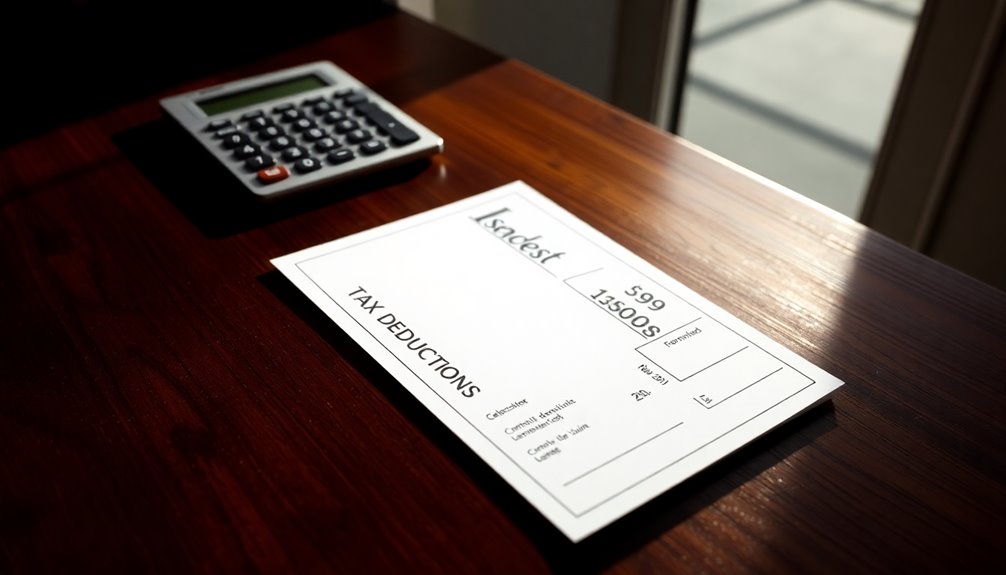Filing taxes as an independent contractor involves a few key steps. First, you'll need to file Form 1040 along with Schedule C and Schedule SE to report your income and expenses. If you receive over $600 from a client, you'll get a Form 1099-NEC, which you'll also need when filing. Don't forget to make quarterly estimated payments if your tax liability is expected to exceed $1,000. Keeping accurate records can help you claim deductions on business expenses. To ensure you're fully informed about your obligations, there's more insight to explore on this topic.
Key Takeaways
- Gather necessary forms, including Form 1040, Schedule C, Schedule SE, and any 1099-NEC received for accurate reporting.
- Report all income earned on Schedule C and deduct eligible business expenses to determine net profit or loss.
- File taxes annually by April 15 and consider making quarterly estimated payments if your tax liability exceeds $1,000.
- Keep organized records of all income and expenses to streamline the filing process and avoid penalties.
- Consult a tax professional for complex situations and stay updated on tax law changes that may affect your filings.
Understanding Independent Contractor Status

Understanding independent contractor status is crucial for anyone navigating the gig economy or freelancing. You're essentially self-employed, working on a temporary or contracted basis, separate from traditional employees. The IRS classifies you as an independent contractor if the payer only controls the outcome of your work, not how you accomplish it. This status is common among various professionals, including freelancers, doctors, and lawyers.
As an independent contractor, you're paid per project instead of by the hour or salary. You provide your own tools and materials, allowing you the freedom to work for multiple clients simultaneously and even off-site. You're also not required to adhere to a set schedule, offering flexibility in how you manage your time. Additionally, as an independent contractor, you are responsible for your own Social Security and Medicare taxes, which further distinguishes your status from that of traditional employees.
However, it's essential to remember that you're not covered under most federal employment laws, meaning you won't receive traditional employment benefits like health insurance or retirement plans.
The classification of your work must align with independent contractor criteria; employers can't misclassify you to escape legal responsibilities. Understanding this status helps you navigate your responsibilities and rights effectively in the gig economy.
Required Tax Forms

As an independent contractor, you'll need to gather specific tax forms to accurately report your income and expenses. The most crucial form you'll encounter is the 1099-NEC. You'll receive this from clients who paid you $600 or more for your services, and it's essential for reporting nonemployee compensation. Clients must provide it to you by January 31 of the following year.
Next, you'll need to complete Schedule C (Form 1040). This form allows you to report your business income and claim related expenses, helping you calculate your net profit or loss. If you're a sole proprietor or single-member LLC, this form is a must for your individual tax return.
Additionally, Schedule SE is necessary if your net income from self-employment is at least $400. It calculates your self-employment taxes, which include Social Security and Medicare contributions. Understanding your tax obligations is crucial to ensuring compliance and maximizing profitability.
Don't forget to fill out Form W-9. Although you won't file this form with the IRS, it's important to provide your Taxpayer Identification Number (TIN) to clients for accurate reporting.
Keeping these forms organized will streamline your tax filing process.
Making Quarterly Estimated Payments

Making quarterly estimated payments is a crucial step for independent contractors to avoid surprises at tax time. If you expect to owe more than $1,000 in taxes for the year, you'll need to make these payments. This requirement applies if your withholding and tax credits are less than 90% of your estimated tax liability for the current year or 100% of what you owed last year.
If your freelance or contracting work earns you $3,000 or more in profit, you're generally required to pay.
To calculate your quarterly tax payments, start with your adjusted gross income from self-employment. Use IRS Form 1040-ES as a worksheet to determine the amount. Keep in mind your total income, filing status, and any deductions or credits. Accurate reporting of revenue and expenses lowers your overall tax burden and helps ensure you're not caught off guard.
It's wise to set aside about 30% of each paycheck as a precaution.
Payments are due on April 15, June 15, September 15, and January 15 of the following year. You can pay electronically through EFTPS.gov or by mailing a check with the corresponding 1040-ES voucher.
Being diligent about these payments helps you avoid penalties and interest later on.
Annual Tax Filing Process

Filing your annual taxes as an independent contractor can feel overwhelming, but breaking it down into manageable steps simplifies the process.
Start by gathering necessary documents. You'll need Form 1040, Schedule C to report your business income and expenses, and Schedule SE for calculating self-employment taxes. Don't forget the 1099-NEC forms from clients who paid you $600 or more, along with receipts for business expenses.
Next, compile your business income and expenses. Summarize your earnings from all the 1099-NEC forms and organize your receipts to determine total expenses. Use Schedule C to calculate your net profit or loss. One important aspect to keep in mind is that independent contractors must pay self-employment taxes on their net earnings.
Once you have everything compiled, complete Form 1040 using the information from Schedule C and Schedule SE. You can file your taxes online or by mail.
Before you submit, double-check all forms for accuracy.
Tax Deductions Overview

Understanding the various tax deductions available to independent contractors can significantly reduce your taxable income and save you money.
As an independent contractor, you can deduct business expenses such as home office costs, including rent and utilities, if you use part of your home for work. Don't forget to track your car expenses too; you can choose to deduct either your mileage or actual expenses like fuel and maintenance. Home office deduction can be claimed for up to 300 square feet of your home office space, providing a substantial write-off.
Office supplies, tools, and equipment necessary for your work are also deductible. If you're in a fitness-related business, expenses for fitness equipment used for business purposes can be deducted.
Additionally, you can deduct professional and operational expenses like business insurance premiums, fees for consulting services, and advertising costs. Make sure to include your health insurance premiums if you're self-employed.
Don't overlook educational and development expenses, which include costs for courses and professional memberships.
Finally, take advantage of tax-specific deductions such as the self-employment tax deduction and qualified business income deduction. Documenting these expenses accurately will help maximize your deductions and minimize your tax burden.
Important Deadlines and Compliance

As an independent contractor, keeping track of important tax deadlines is crucial to avoiding penalties and ensuring compliance.
You'll need to make quarterly estimated tax payments by April 15, June 15, September 15, and January 15 of the following year. Use Form 1040-ES to calculate and submit these payments, which cover your income for each quarter. Missing or underpaying these can lead to penalties. Additionally, self-employment tax is a significant consideration as it covers Social Security and Medicare contributions, which are essential for your long-term financial planning.
Your annual income tax return is due on April 15. If it falls on a weekend or holiday, the deadline shifts to the next business day. File Form 1040 along with Schedule C and Schedule SE. You can request a six-month extension using Form 4868, but remember, taxes still need to be paid by the original deadline.
Additionally, businesses must report payments of $600 or more to you using Form 1099-NEC by January 31. You should receive a copy, and Form 1096, along with the 1099s, must be submitted to the IRS by February 28.
Keep accurate records of your income and expenses to ensure timely and correct submissions, helping you avoid unnecessary penalties.
Frequently Asked Questions
How Do I Determine My Independent Contractor Tax Rate?
To determine your tax rate as an independent contractor, start by calculating your net earnings.
Subtract your business expenses from your gross income. Then, apply the self-employment tax rate of 15.3% to 92.35% of your net earnings.
Remember, you might also need to account for additional Medicare tax if your earnings exceed certain thresholds.
Don't forget to gather all 1099 income to get an accurate picture of your total earnings.
Can I Hire Subcontractors as an Independent Contractor?
Yes, you can hire subcontractors as an independent contractor.
This allows you to leverage their expertise for tasks beyond your skill set, improving the overall quality of your project.
You'll save time and costs associated with full-time employees, as subcontractors work on a project basis.
Just make sure to do thorough research, evaluate their background, and draft a detailed contract to outline the terms of your working relationship.
What Records Should I Keep for Tax Purposes?
For tax purposes, you should keep several key records.
Maintain invoices for at least 7 years, along with project records like contracts and correspondence.
Track your business expenses with receipts and use mileage logs for travel, storing them for 3 years.
Don't forget to keep copies of tax returns for 3 years and Form 1099-NEC if you earned $600 or more.
Accurate records will help you report income and claim deductions effectively.
How Do I Handle State Taxes as an Independent Contractor?
Handling state taxes as an independent contractor involves understanding your specific obligations.
You'll need to pay state income taxes and possibly make estimated quarterly payments if you anticipate owing over $1,000.
Make sure to file state-specific forms alongside your federal returns.
Keep track of deadlines, as they often align with federal ones.
Also, consider claiming any available deductions and credits to reduce your taxable income and avoid penalties for underpayment.
What Happens if I Miss the Quarterly Payment Deadlines?
If you miss the quarterly payment deadlines, the IRS imposes penalties for underpayment.
You'll face a 0.5% penalty on the unpaid amount for each month it remains unpaid, up to 25%. Interest also accrues on what you owe.
To minimize these consequences, pay the missed amount as soon as possible, and consider making a partial payment if you can't pay in full.
Keeping records of your payments is essential for your financial management.
Conclusion
Filing taxes as an independent contractor doesn't have to be overwhelming. By understanding your status, using the right forms, and keeping track of your deductions, you can simplify the process. Don't forget to make those quarterly estimated payments to avoid penalties! Stay on top of deadlines and maintain compliance to keep your finances in order. With a bit of organization, you'll navigate tax season with confidence and ease. You've got this!









